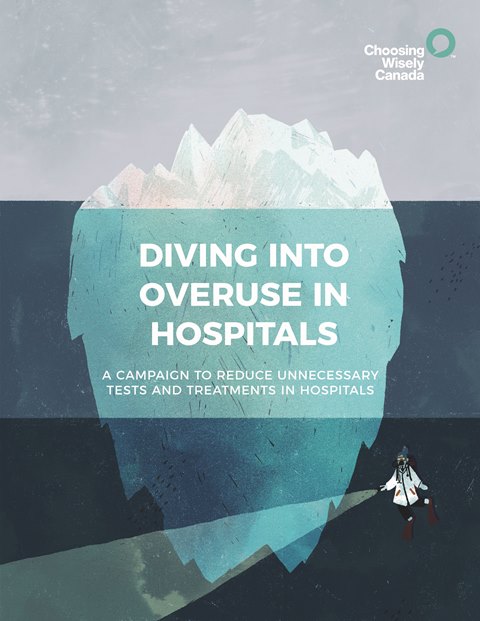By Tai Huynh
This month, Choosing Wisely Canada, the national voice for reducing tests and treatments in health care, is launching a new campaign, Diving into Overuse in Hospitals The goal of the campaign is to get hospitals across Canada to join the global Choosing Wisely movement by making changes, small or large, to reduce overuse. Participating hospitals get access to a wealth of resources, including a starter kit, webinars and other supports. Hospitals interested in being part of this, but are not sure if they have an overuse problem are encouraged to ask themselves the five basic questions below. A ‘yes’ answer to any of the questions means your hospital has an overuse problem. Even if the answers are ‘no’ across the board, the starter kit suggests ways hospitals can do a deeper dive to uncover other signs of overuse and what to do about it. The campaign hopes to mobilize and empower hospital staff to pause, question long-standing practices and take leadership on reducing overuse, avoiding potential harm to patients and freeing up precious hospital resources for more important uses.
| Overuse in My Hospital: Five Questions to Ask |
| 1. Does my emergency department order both PT/INR and aPTT tests as a bundle? |
| 2. Does my hospital still use CK testing to diagnose a heart attack? |
| 3. Are inpatients at my hospital getting daily blood tests automatically? |
| 4. Does my hospital still test serum & red blood cell folate levels? |
| 5. Does my ICU still order routine x-rays for all patients? |
Unnecessary testing and treatment is a pervasive problem in health care. It is present virtually every hospital, department and clinic, irrespective of size or how diligent the clinicians are who work there. A 2017 report from the Canadian Institute for Health Information showed that in many clinical areas, up to 30 per cent of tests and treatments are potentially unnecessary. Take preoperative tests before low-risk surgery (such as endoscopy and cataract removal) as an example. Evidence shows that these types of tests do little to improve care, and the results can distress patients and waste resources. Yet, the report showed that in Ontario, Saskatchewan and Alberta, 18 to 35 per cent of patients who had a low-risk procedure had a preoperative test.
While clinicians ultimately make decisions about which tests and treatments to order based on the assessment of an individual patient, many of these decisions can often be influenced by hospital systems and processes that, if outdated or poorly designed, can nudge clinicians toward ordering tests and treatments that do not reflect evidence-based guidelines and practices. This can expose patients to avoidable harm, lengthen wait times, and consume precious hospital resources.
Examples of hospital systems and processes that can drive overuse include: order sets, medical directives, lab order panels and computerized order entry systems, among others. Uncovering and refining systems and processes that are out of date or not evidence-based is one of the most effective ways to curb overuse within the hospital environment. There are many examples of this in lab testing, such as PT/INR and aPTT ordering. This is one of the targets of the Diving into Overuse in Hospitals campaign. PT/INR (prothrombin time/international normalized ratio) and aPTT (activated partial thromboplastin time) were tests developed in the early 20th century for specific and unique indications. Despite this, they are often ordered together routinely in emergency departments. PT/INR and aPTT are often unknowingly ordered together because most blood work in the emergency department is based on lab order panels that are outdated, often coupling PT/INR and aPTT tests as a bundle despite the fact that they are rarely required together. In some hospitals, laboratory software may also automatically run both tests even if only one was ordered. One teaching hospital in Ontario decided to uncouple PT/INR and aPTT and revise their emergency department test panels, which resulted in a 50 per cent reduction in both tests.
Historical practices that have, over time, become routinized and ‘baked’ into the system set the course of overuse on auto-pilot, often taking decision-making out of the hands of busy clinicians, for better and for worse. On the one hand, there needs to be systems and processes to help stream workflow, improve consistency and standardization and take complexity out of everyday decisions. On the other hand, these systems and processes have their own inertia, and when they do not keep up with the evidence, they act as vectors for antiquated practices, allowing overuse to quickly multiply.
To date, Choosing Wisely Canada has partnered with over 70 professional societies from different clinical specialties and disciplines to develop lists of “Things Clinicians and Patients Should Question.” These lists contain recommendations of tests, treatments and procedures that are not supported by evidence and could potentially expose patients to harm. Since the campaign launched in 2014, over 300 recommendations have been published, a significant number of which deal with unnecessary tests, treatments and procedures within the hospital setting. Diving into Overuse in Hospitals offers an opportunity to put these recommendations into practice to improve quality of care in hospitals, avoid harms from overuse to patients and improve stewardship of valuable resource
Tai Huynh is Campaign Director, Choosing Wisely Canada.


